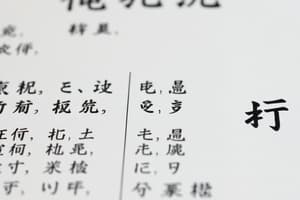Podcast
Questions and Answers
What is the meaning of '学生'?
What is the meaning of '学生'?
- Good
- Home
- Student (correct)
- Teacher
In the sentence '我在家', the word '家' means school.
In the sentence '我在家', the word '家' means school.
False (B)
How do you turn the statement '你是老师' into a yes/no question?
How do you turn the statement '你是老师' into a yes/no question?
你是老师吗?
The word '新' means __________.
The word '新' means __________.
Match the following phrases with their meanings:
Match the following phrases with their meanings:
Which of the following correctly follows the Subject-Verb-Object structure?
Which of the following correctly follows the Subject-Verb-Object structure?
In the dialogue practice, person A greets person B with '你好!'.
In the dialogue practice, person A greets person B with '你好!'.
What does '我很好' mean?
What does '我很好' mean?
'书' means __________.
'书' means __________.
How would you respond to '谢谢' to indicate politeness?
How would you respond to '谢谢' to indicate politeness?
What does '请问' translate to in English, and in what context would it be used?
What does '请问' translate to in English, and in what context would it be used?
Rephrase '我很好' into a question using '吗'.
Rephrase '我很好' into a question using '吗'.
Construct a sentence using '我' and '爱' to express love for something.
Construct a sentence using '我' and '爱' to express love for something.
If someone says '对不起', how would you respond to indicate it’s not a problem?
If someone says '对不起', how would you respond to indicate it’s not a problem?
Identify the basic sentence structure in '我昨天去商店'.
Identify the basic sentence structure in '我昨天去商店'.
In the dialogue, how does person B respond to person A's greeting?
In the dialogue, how does person B respond to person A's greeting?
Flashcards are hidden until you start studying
Study Notes
Vocabulary
- 新 (xīn) - new
- 老师 (lǎoshī) - teacher
- 学生 (xuéshēng) - student
- 书 (shū) - book
- 在 (zài) - at/in
- 家 (jiā) - home/family
- 吗 (ma) - question particle
- 好 (hǎo) - good
Grammar Rules
-
Question Formation: Use "吗" at the end of a statement to turn it into a yes/no question.
- Example: 你是学生吗? (Nǐ shì xuéshēng ma?) - Are you a student?
-
Subject-Verb-Object Structure: Follow the SVO order in sentences.
- Example: 我在家 (Wǒ zài jiā) - I am at home.
-
Adjective Placement: Adjectives come before nouns.
- Example: 新书 (xīn shū) - new book.
Dialogue Practice
- A: 你好! (Nǐ hǎo!) - Hello!
- B: 你好! 你是老师吗? (Nǐ hǎo! Nǐ shì lǎoshī ma?) - Hello! Are you a teacher?
- A: 是的,我是老师。你是学生吗? (Shì de, wǒ shì lǎoshī. Nǐ shì xuéshēng ma?) - Yes, I am a teacher. Are you a student?
- B: 是的,我是学生。 (Shì de, wǒ shì xuéshēng.) - Yes, I am a student.
Sentence Structure
-
Basic format: Subject + Verb + Object
- Example: 我 (subject) 在 (verb) 学校 (object) - I am at school.
-
Use of "在" to indicate location.
- Example: 我在家 - I am at home.
Common Phrases
- 你好吗? (Nǐ hǎo ma?) - How are you?
- 我很好。 (Wǒ hěn hǎo.) - I am very good.
- 谢谢! (Xièxiè!) - Thank you!
- 不客气! (Bù kèqì!) - You’re welcome!
Vocabulary
- 新 (xīn) means "new," indicating something that has recently come into existence or been made.
- 老师 (lǎoshī) translates to "teacher," referring to an individual who educates students.
- 学生 (xuéshēng) means "student," describing a person who is learning, particularly in an academic setting.
- 书 (shū) is the word for "book," representing a collection of written or printed pages, typically bound together.
- 在 (zài) signifies "at" or "in," used to indicate location or a state of being.
- 家 (jiā) translates to "home" or "family," referring to a place of residence or familial unit.
- 吗 (ma) is a question particle used at the end of statements to form yes/no questions.
- 好 (hǎo) means "good," often used to express approval or well-being.
Grammar Rules
- Formulating questions in Chinese involves adding "吗" to the end of a statement, converting it to a yes/no question.
- The standard structure of sentences follows a Subject-Verb-Object (SVO) format, indicating the order of components.
- Adjectives are placed before nouns, which is essential for correct sentence formation.
Dialogue Practice
- Greeting expressions include "你好!" (Nǐ hǎo!) meaning "Hello!"
- Conversations typically include inquiries about roles, such as asking if someone is a teacher or student.
- Responses affirming one's identity follow a structured format, confirming or denying the questioner's inquiry.
Sentence Structure
- The basic sentence format emphasizes Subject + Verb + Object, clearly depicting who is doing what.
- The word "在" is crucial for locating nouns and stating physical presence, like "我在家" (Wǒ zài jiā) meaning "I am at home."
Common Phrases
- "你好吗?" (Nǐ hǎo ma?) translates to "How are you?" facilitating casual conversation.
- Responses such as "我很好。" (Wǒ hěn hǎo.) meaning "I am very good." express well-being.
- Polite exchanges include "谢谢!" (Xièxiè!) for "Thank you!" and the response "不客气!" (Bù kèqì!) meaning "You’re welcome!"
Vocabulary Essentials
- 你好 (nǐ hǎo) means "Hello" in Chinese.
- 再见 (zài jiàn) translates to "Goodbye."
- 谢谢 (xiè xiè) is the phrase for "Thank you."
- 不客气 (bú kè qì) means "You're welcome," a polite response to thanks.
- 对不起 (duì bù qǐ) expresses "Sorry," used to apologize.
- 没关系 (méi guān xì) translates to "It's okay," often in response to an apology.
- 请 (qǐng) is used for "Please," a word for polite requests.
Dialogue Practice Highlights
- Typical greetings involve the exchange of "你好" and inquiries about well-being.
- Responses can include affirmation of good health and polite farewells.
- Example exchange illustrates basic conversational flow using greetings and well-wishes.
Fundamental Grammar Rules
- Identification is expressed with “是 (shì), structured as Subject + 是 + Noun.
- Example: 我是学生 (I am a student).
- Questions are formed by adding “吗 (ma)” at the end of a statement.
- Example: 你好吗? (Are you good?)
Sentence Structure Basics
- Standard sentence format follows Subject + Verb + Object structure.
- Example: 我爱你 (I love you).
- Time expressions are positioned before the verb for context.
- Example: 我昨天去商店 (I went to the store yesterday).
Common Phrases for Interaction
- 你好吗? (nǐ hǎo ma?) is a common way to ask "How are you?"
- 我很好 (wǒ hěn hǎo) means "I’m good," a typical response.
- 请问 (qǐng wèn) is used to politely introduce a question or ask for information.
- 我不明白 (wǒ bù míng bái) translates to "I don’t understand," useful for clarifying.
- 你会说中文吗? (nǐ huì shuō zhōng wén ma?) means "Can you speak Chinese?" often used when engaging with Chinese speakers.
Studying That Suits You
Use AI to generate personalized quizzes and flashcards to suit your learning preferences.




